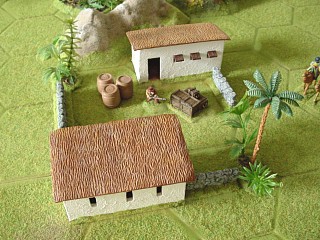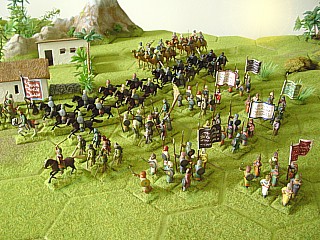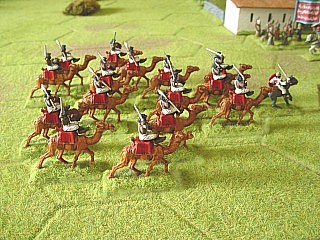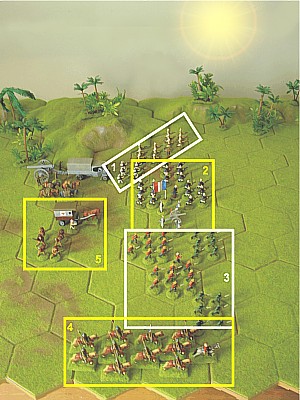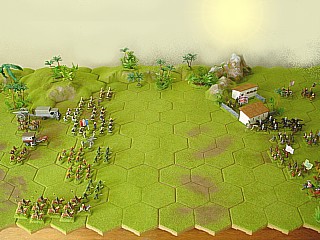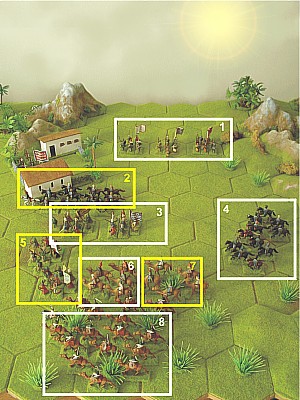"Battle for Maxim's".
The gateway to the Valley of Death.
SCENARIO NOTES - TO VIEW THE BATTLE CLICK HERE.
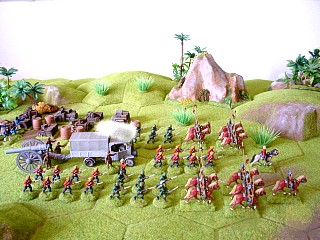
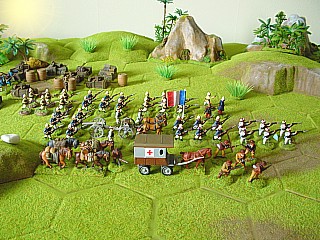
- two 8 fig B-class sepoy units (scarlet & blue uniforms).
- two 6 fig A-class Ghurkas (green uniforms).
- two 5 fig A-class Bengal lancers.
- one A-class (steam drawn) heavy artillery unit (4 figs).
Two officers: Lord Hamilton on horseback and a Captain on foot.
"Unit colours" (see rules) are mixed red-green-blue. Contrary to the French, who proudly fly their "Tricolore", Lord Hamilton keeps a low profile and does not display the colours.
- three 6 fig A-class French regular units (blue & white uniforms).
- two 6 fig A-class "Légion Etrangère" units (light khaki uniforms).
- one 6 fig A-class "Infanterie de Marine" unit.
- one 6 fig volunteer unit "Maxim's Rifles".
- one A-class artillery unit (4 figs), a medical and a supply unit.
Two officers (Rico Sanscheveux and a Captain) and 1 sergeant, all on foot.
"Unit colours" (see rules) are mixed red-green-blue.
| Volunteer
units: are"special
units" not mentioned in the basic "Afriboria"
rules. Volunteer
units are composed of European civils with modern weapons and have
the
following specs: - B-class for morale purposes (flags); - battle as A-class, be it without the benefit of the "not moving and firing twice" rule. This reflects the quality of their arms but also their lack of military training. |
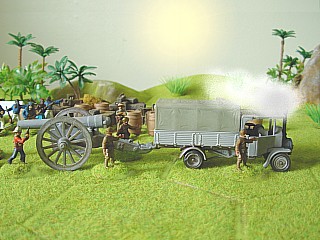
A-class (steam drawn) heavy artillery unit
(gun: pencil sharpener - tractor: Lledo Diecast model - both repainted).
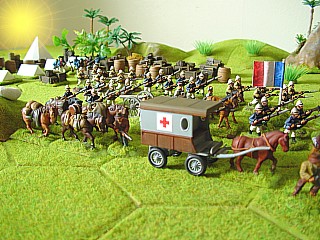
Ambulance unit followed by a supply unit
(ambulance: Lledo Diecast model - repainted).
The A-class (in this case steam drawn) HEAVY ARTILLERY UNIT (4 figs) is a "special unit" not mentioned in the basic "Afriboria" rules. It has the following specs:
|
TYPE
|
MOVE
|
|
DICE&
RANGE
|
Heavy
artillery: If
25/28mm figs with 10cm hexes and a prime mover are used (as in the
picture above), the hex containing the p.m. is the target hex for
enemy attacks. It is more practical to consider the p.m. to be an
integral part of the gun model, but visually less appealing (player's
choice...). When the gun is deployed, the p.m. model is (temporarily)
removed from the table.
|
| Heavy artillery |
1
|
&
|
0
|
|
|
0
|
&
|
4
- 3 - 3 - 2 - 2 - 2 - 1 - 1
|
| The main goal of this type of artillery is to bombard an area or building. This is simulated by restricting the ammo by using one or more small D6 (to represent the number of shells left). As this heavy (and expensive) ordnance would normally not be left unprotected, it may be part of a "platoon" or "company" (see "Afriboria" rules). For as long as another ("covering") unit of such a formation is in the same hex (or adjacent when using 25/28mm figs with 10cm hexes), this "covering unit" must first be forced to retreat (or be eliminated) before the heavy artillery can be attacked. |
The MEDICAL UNIT (in this case a 1 model ambulance unit) is a "special unit" not mentioned in the basic "Afriboria" rules and represents medical capacity.
|
Medical
unit:
moves as infantry and enables the player to
tend to his casualties. To simulate this, AT THE END OF HIS TURN,
the player casts 1 D6: |
The SUPPLY UNIT (in this case 4 packhorses, but could also be a wagon,truck or bunch of porters) is a "special unit" not mentioned in the basic "Afriboria" rules.
| Supply unit: represents the supplies of a western military force in the field. It moves as infantry. Supply units do not have a special function (unless otherwise stated in the scenario), except that they need protection in order to avoid the opponent scoring an easy victory point. In a way, the supply unit represents certain restrictions (due to supplies) an imperialists' field force suffers compared to a native warband. |
| As a medical or supply unit would normally not be left unprotected, It may be part of a "platoon" or "company" (see "Afriboria" rules). For as long as another ("covering") unit of such a formation is in the same hex (or adjacent when using 25/28mm figs with 10cm hexes), this "covering unit" must first be forced to retreat (or be eliminated) before the medical or supply unit can be attacked. Medical or supply units have no attack/defence value and are automatically overrun and eliminated. When overrun, a victory point is added to the opponents' total and the unit is removed from the game. |
